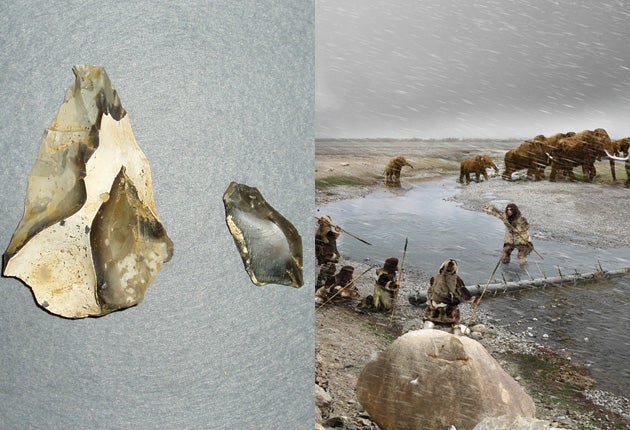Flint findings in Kent reveal new era of prehistory

Archaeologists have discovered a previously unknown epoch in British pre-history when Stone Age hunters re-entered Britain after an absence of up to 90,000 years – because of climatically induced sea-level changes which turned the English Channel into dry land.
Until last month, no proof had ever been found for human occupation in Britain between 200,000 and 65,000 years ago – but now new evidence has revealed a human presence here in the middle of that period.
Although early humans originally arrived in Britain at least 700,000 years ago, they had been repeatedly forced out by particularly cold spells within the Ice Age.
But over subsequent millennia, their descendants and others gradually acclimatised to Europe's intermittently chilly conditions. As these early humans became more used to the cold, they evolved into a separate species of humanity, known as Neanderthal man.
Archaeologists from Southampton University and a commercial excavation unit, Oxford Archaeology, have discovered evidence of stone-tool manufacture, demonstrating that Neanderthals were living in Kent about 110,000 years ago.
Prior to that, the world had been warmer, the ice caps smaller, sea levels higher and the Channel had consequently been full of water and therefore uncrossable.
But then temperatures plummeted, sea levels dropped, the Channel dried up and big game in Britain migrated northwards – and the Neanderthals followed their dinner.
The Kent discovery is an example of how unprepossessing archaeological finds can have huge implications. For the objects which have changed our understanding of such a huge chunk of prehistory are just two pieces of flint – one 8cm-long probable cutting implement and a waste flake, almost certainly discarded while a Neanderthal hunter was making a similar tool.
"They were found in perfect razor-sharp condition near Dartford, on a spur of high ground overlooking the confluence of two rivers – the Darent and a small, now long-vanished tributary," said Dr Francis Wenban-Smith, an archaeologist from Southampton University.
They had probably been lost or discarded by a group of Neanderthal hunters using the spur as an observation point from which to observe herds of migrating horse, deer, mammoth and woolly rhino as they made their way along the river valley below.
The Neanderthals would have moved around in groups of up to 20 to 25 individuals. Usually they would have lived in the open, surviving on a diet of meat, fruit, roots and possibly insects.
They knew how to light and maintain fires – and they relied on spears as their main hunting weapon. It is not known whether or not they wore rudimentary animal-skin clothes – or whether they had to rely on their own probably dense hair cover to keep themselves warm.
The finds have been dated at Oxford University to c110,000BC by a system known as "optically stimulated luminescence" (OSL), a technique often used to date particularly ancient sites. It does this by measuring tiny quantities of light emitted from crystalline material, especially the quartz often found in sand.
The technique uses the quantity of released light to calculate when a grain of sand or other crystalline material was last exposed to sunlight and therefore how long it has been buried for.
Virtually everything on earth is subject to low levels of radiation from naturally occurring radioactive materials. In crystalline material, this radiation produces tiny electrical charges in the form of free electrons.
Some of these electrons get trapped in defects in the crystalline matrix. Normally this trapped energy manages to escape – but when material is buried, the solar light energy which triggers the release of trapped electrons is no longer available. As a result, the electrons stay trapped inside the defects in the crystal until the material is re-exposed to light.
Subscribe to Independent Premium to bookmark this article
Want to bookmark your favourite articles and stories to read or reference later? Start your Independent Premium subscription today.

Join our commenting forum
Join thought-provoking conversations, follow other Independent readers and see their replies